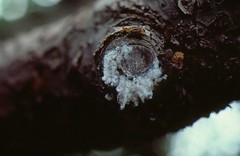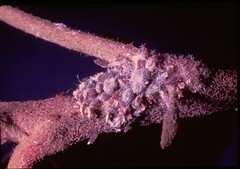The woolly apple aphid, Eriosoma lanigerum (Hausmann), is a reddish brown insect covered with a white wax mass produced by specialized dermal glands. This wax mass gives the insect its characteristic woolly appearance (fig. 1). The woolly apple aphid is distributed worldwide.
The most important form of injury caused by woolly apple aphids is root injury, consisting of galls at feeding sites (fig. 2). This root injury can reduce the growth of young apple trees; mature trees are affected to a lesser degree. The Malling-Merton (MM) series of rootstocks (derived from ‘Northern Spy’) was bred for resistance to woolly apple aphid. Although MM rootstocks do not provide total resistance, infestation levels are lower than on other rootstocks. Choosing MM rootstocks is a recommended control tactic.
| Figure 1. Woolly apple aphid colony on an apple pruning wound. Photo: Henry W. Hogmire, Jr., West Virginia University. | Figure 2. Root damage from woolly apple aphid. Photo: Mark Brown, USDA. |
|---|---|
 |
 |
| Figure 3. Woolly apple aphid colony on a small apple branch. Photo by Henry W. Hogmire, Jr., West Virginia University. |
|---|
 |
Woolly apple aphids have a simple metamorphosis: parthenogenic (development of the egg without fertilization). Woolly apple aphids overwinter as eggs or in young nymphal stages underground in root galls and as adult egg-laying females on the branches and trunks of host plants. The female lays eggs in bark cracks in the fall, and the eggs hatch in early spring. First instar nymphs are highly mobile and will disperse from crowded populations to establish new colonies and move between the roots and shoots throughout the year. Wingless nymphs feed on new growth and twigs for two generations, producing winged forms that fly to other host plants (apple, hawthorn, mountain ash, pear, and plum). In the summertime the females give birth to live young. The wingless males are produced in the fall and mate with wingless females, each of which lays a single overwintering egg.
Aphid colonies on the trunk, branches, or twigs can cause deformations (fig. 3), blisters, splitting, and canker-like swellings of the bark. The compounds in aphid saliva that are toxic to trees are partly responsible for the severity of this damage. Galling of aerial plant parts can reach the size of a walnut and interfere with sap circulation.
In the spring, monitor aphid population levels by routinely (once or twice a week) inspecting plant parts. Look for whitish colonies on protected feeding sites on the branches and trunk, especially around healing pruning cuts or wounds in the bark. From mid to late summer, inspect the leaf axils for signs of the aphids. Yellow sticky cards, available from garden stores and nurseries, are effective tools for monitoring winged aphid populations.
Most aphid populations are moderated by natural controls that include environmental stresses, such as high winds, heavy rains, and extreme temperatures, and natural enemies, such as lady beetles, green lacewings, syrphid fly larvae, damsel bugs, braconid and chalcid wasps, and parasitic fungi. In some cases, doing nothing is the best course of action because populations naturally build up and decline quickly. The reproduction rate of aphids depends on food quality, host plant species, moisture, and temperature. Good horticultural and agronomic cultural methods can help discourage aphid outbreaks.
Dislodging the aphids by spraying the host plants with water at high pressure may be an ideal way to control them in small plantings. Also, you can purchase natural enemies from commercial insectaries and release them to help reduce aphid numbers. Biological control agents, such as Insect growth regulators, microbial insecticides, and insecticidal soaps, can help control aphids while having the least impact on natural enemies.
Most insecticides are applied to plants as a foliar spray or as a soil treatment. Some foliar sprays (acephate, dimethoate) and soil treatments (disulfoton, imidacloprid, oxamyl) are systemic insecticides. These products are taken up by the plant and make its tissues and fluids toxic to the feeding aphids. Apply nonsystemic, contact insecticides to all infested plant surfaces for best results because these insecticides must come into direct contact with the insects. You may need to make several applications at 7- to 10-day intervals, or as instructed by the product label, before achieving an acceptable level of control.
Deborah Blue, West Virginia University
